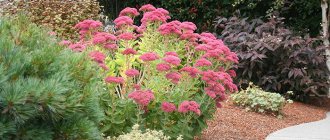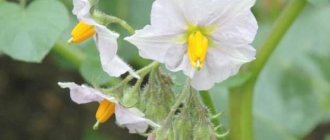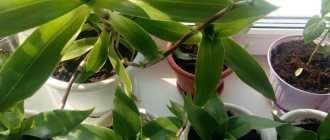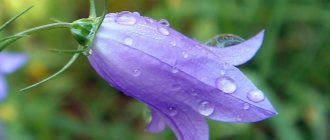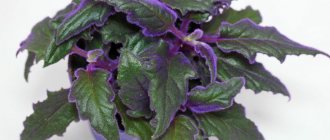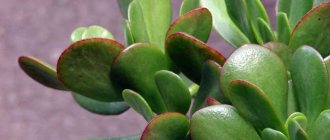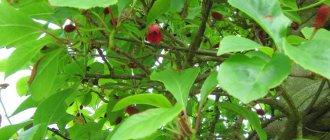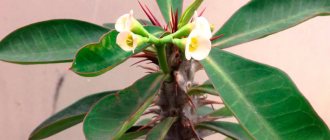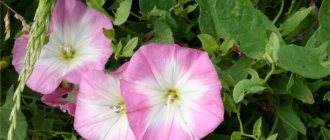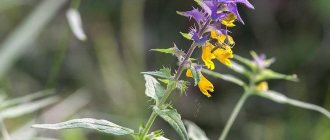Schisandra chinensis is an actively climbing, deciduous vine that has been grown for hundreds of years and is said to belong to the Schisandra family.
This plant also has other names. For example, “ts-wei-tzu”, which translates as a berry that has five different tastes at once.
If you look at a photo of Chinese lemongrass, the first thing that will immediately catch your eye is the length of the plant, which sometimes reaches fifteen meters.
The stem of the plant is quite branched and wrinkled in some places. Its thickness varies from 1.5 cm to 2 cm. The color of the stem is primarily affected by its age.
Thus, old plants are distinguished by predominantly chocolate-brown bark, but in young specimens it is yellowish and even shiny in some places.
Botanical description
The leaves are 10 cm in size. They are pointed at the top and have a wedge-shaped base at the bottom. The surface of the foliage is glossy, the color is dark green.
The flowers look attractive. When fully expanded, they acquire a pinkish tint. In good conditions for growing lemongrass, you can get a lot of berries that taste good. Each fruit is red in color. The fruits can be used to prepare preserves and jams.
The tree blooms in the last May - first June weeks. The culture is pleasing to the eye for 14 days. The berries are fully ripened at the end of September.
Jams, jelly and soft drinks are prepared from lemongrass fruits. The taste of berries as a candy filling is original. The leaves and bark are used to make aromatic tea.
Plant growing process
According to available information, the cultivation of Schisandra chinensis began around 250 BC. on the territory of Ancient China, solely for subsequent adoption for treatment.
A little later, the plant also became widespread in the Far East, where residents often used it when it was necessary to quickly restore their strength.
Today, if you are interested in planting Schisandra chinensis, in its familiar wild form, it grows quite calmly on the territory of Sakhalin, as well as China, Korea and Japan.
Here you can easily see lemongrass in the Khabarovsk and, for example, Primorsky territories.
Manifold
Species and varieties of lemongrass are not represented in such large quantities as other crops. The following are popular:
A self-pollinating, highly productive winter-hardy variety is Sadovyi-1. The tree grows spherical, juicy and sour berries that are red in color and have a rather aromatic lemon smell. They are collected in brushes.
The Mountain variety is distinguished by its originality. It is characterized by winter hardiness, productivity, high resistance to the development of diseases and the influence of insect pests. The fruits ripen in September.
The Volgar variety is winter-hardy and drought-resistant. It withstands the effects of diseases and pests. The berries are tasty and juicy.
The fruits of the Pervenets variety look original. The tree can withstand fairly low temperatures and does not require insulation or covering for the winter. The taste of berries attracts the attention of many children and adults.
Myth looks amazing. The variety belongs to hybrids. The berries have a tart taste. They are equally readily used fresh and in compotes. Experts note its high resistance to sub-zero temperatures, the development of dangerous diseases and insect pests. Gives a high yield every year.
There are some other varieties, but they grow quite rarely in gardens.
Kinds
There are a total of 25 species of Schisandra, but only a few are cultivated. The most popular is Chinese, which is common even in the northern part of Russia, although the plant does not have large yields there. This species is distinguished by large flowers, the diameter of which can reach 15 centimeters. Chinese lemongrass begins to bloom closer to summer. Another type is Crimean. It is distinguished by its frost resistance, it loves well-lit areas and blooms in early summer. The shrubs of the plant are low, reaching a maximum of 70 centimeters in height. This type is used for preparing tinctures, namely tea.
The benefits of culture
Already in ancient times, people noted the beneficial properties of lemongrass. It was used in the following cases:
- to boost the immune system to prevent the development of dangerous viral infections;
- berries normalize the acidity of gastric juice;
- eliminates fatigue;
- increases blood pressure;
- relieves asthma;
- allows you to cope with significant mental or physical stress;
- prevents the development of respiratory system diseases.
Methods of application
Schisandra chinensis has a lot of beneficial properties, so its use is justified in folk medicine and recognized in official medicine. The pharmaceutical industry produces the following dosage forms based on Far Eastern Schisandra:
- Pills. This is a combination of extract from the fruits of the liana and the Terra-Plant flavonoid complex, which has mild tonic properties. They are absorbed for better absorption.
- Syrup. In addition to lemongrass, it includes rosehip extract and ascorbic acid. The useful composition will support you during the cold season and help you out when you lose strength.
- Fruit powder. Exported from China. Useful, stimulating decoctions are prepared on its basis or taken in dry form with water.
- Tincture. Consists of Schisandra chinensis seeds and 95% alcohol. Recommended for asthenic syndrome. Due to alcohol, which is quickly absorbed into the blood, you don’t have to wait long for an invigorating effect.
- Fruit. Sold in pharmacies in the form of dried berries. Infusions, decoctions, teas, syrups, and compotes are prepared from them. All of them are saturated with useful substances.
- Oil. Essential oil is classified as cosmetic because it has the ability to moisturize, regenerate and rejuvenate the skin. Schisandra oil is used as a massage oil and is used in aromatherapy.
- Herbal teas. In addition to the Far Eastern vine with a stimulating effect, they also include other medicinal herbs. For example, one of the options is adding rose hips and rhizomes of the tea plant. Each herbal tea is designed to have a specific positive effect on the body. Based on the set of plant materials, the beneficial properties of the plant appear.
How to properly use medicines containing the Far Eastern liana is indicated on the packaging of pharmaceutical preparations. It should be remembered that Far Eastern Schisandra contains potent substances, so before taking them it is useful to get a doctor’s opinion.
Contraindications
There are cases when lemongrass cannot be used in any form. Avoid using the product if the following pathological processes develop:
- in cases of arterial hypertension development;
- with increased excitability;
- with vegetative-vascular dystonia;
- with the development of increased intracranial pressure;
- for allergic reactions;
- when arachnoiditis appears;
- with epileptic manifestations;
- for problems with sleep;
- in a state of pregnancy;
- in case of acute infectious disease.
He also recommends not eating lemongrass berries if a person develops kidney or liver pathologies. This will lead to aggravation of the condition. It is better to consult a doctor if various pathological processes develop.
We collect and prepare the plant
Of course, Chinese lemongrass berries are best picked when they are fully ripe. The fruit ripening time for this plant begins in the fall and continues until the first cold nights.
It is important to very carefully cut off all the brushes that have berries on them. It is advisable to use a sharp enough knife for these purposes.
Try not to damage existing vines, because if the plant loses its main support, it can quickly stop bearing fruit.
After receiving the information on how to plant Chinese lemongrass, it is important to think about what container you will use in the future to collect the fruits. It is best if these are baskets or, for example, barrels prepared in advance.
You should avoid using galvanized buckets, as this can lead to their rapid oxidation due to berry juice. Processing of collected fruits must be carried out within the next twenty-four hours after collection. This is necessary to preserve the medicinal properties of Chinese lemongrass.
How to plant lemongrass and care for it
When to plant lemongrass, each gardener decides for himself. This can be done in spring or autumn. Only in the latter case is it necessary to plant the plant in the soil at such a temperature that it takes root. If lemongrass is planted in the garden in frosty weather, the seedling will die.
Select well-lit areas for seedlings. The soil should be loamy, slightly acidic.
Although the culture is quite unpretentious, it grows and develops better if the necessary care is provided. The soil around the seedling should be loosened. This will attract enough air to the roots, allowing them to grow better.
The seedling has enough strength to feed itself. The roots are able to pull all the necessary substances from the soil. The seedling should be fed several times. The procedure is performed before the start of active vegetative growth, during flowering, and also after fruiting. This will allow the crop to produce a bountiful harvest every year.
In hot weather, the seedling should be watered. It also responds well to spraying. The procedure is carried out using settled water for 24 hours. Otherwise, the tree may get sick.
Schisandra pruning is also necessary. The procedure is carried out by specialists in late autumn. To do this, cut the stems, leaving 15-20 centimeters of shoots. A sufficient number of buds are left on each. If necessary, pruning is repeated in the spring.
To cope with pests and diseases of lemongrass, the tree should be treated with special preparations. To carry out the procedure, various means are used, which are widely represented in the store chain. The use of drugs should be avoided at the time of fruiting, as the berries will accumulate toxins and become dangerous to human health.
To prevent weeds from growing around the lemongrass, mulch the surface with a special material. This will reduce labor costs.
Schisandra is an excellent fruit-bearing tree. It produces a bountiful harvest with minimal care, which consists of regular loosening, pruning, and treatment against diseases and insect pests.
Planting in open ground
Soil preparation
In the southern regions, lemongrass is planted in September-October, in other regions - in late April-early May.
2 weeks before planting, prepare holes 40 m deep and 70 cm in diameter. The soil should be loose and rich in humus. If there is acidification of the soil, then add 400 grams. lime per 1 sq. m. A drainage layer (broken brick, small crushed stone), up to 10 cm thick, is placed in the holes. Then a mixture of humus, compost, leaf soil, superphosphate (1 cup) and wood ash (0.5 kg) is added. After 2 weeks, the soil is ready for planting, by which time it will have compacted and settled.
The seedlings must have healthy and developed roots, 10-15 cm in height and 2-3 years old. The bushes are placed at a distance of 100 cm from each other. After planting, create a roller of soil around the hole (10 cm). The bushes are watered abundantly and the hole is filled with peat or humus; fresh manure will destroy the roots of lemongrass.
Types of planting
Schisandra is propagated in the following ways: seeds, cuttings, offshoots and root suckers.
Landing Features
The seed method is the most popular. In the fall, you can plant freshly collected seeds. They will overwinter in the soil and sprout when warmer weather arrives. In the spring, seeds are planted that have undergone stratification for 2 months. Then they are planted in containers with special soil to a depth of 5 mm. The containers are covered with paper. Water them every day. After 2 weeks, shoots will appear. They are protected from direct sunlight and disinfected with a weak solution of potassium permanganate (1-2 times). After 3 true leaves appear, the plants are transferred to larger containers at a distance of 5 cm from each other. The plants are gradually hardened off and taken out into fresh air every day for 2 weeks. In early June, lemongrass is planted in open ground in partial shade.
Propagation by cuttings begins in early July. To do this, cut off the upper part of the young shoots and place them in Kornevin’s solution for a day. Then they are planted in wet river sand. The pot with cuttings is covered with glass or a plastic bottle.
Reproduction by offsets begins in April, while there is no sap flow. Choose annual strong shoots. They need to be bent to the ground, secured with wire and sprinkled with peat or humus 15 cm thick. After 4-5 months, roots will appear on the branches, but lemongrass will form only after 1.5-2 years. After 2 years, the branch is separated from the mother bush and transplanted to a permanent place.
Reproduction by root suckers begins in late April-early May. Several offspring are selected, distant from the mother bush, dug up and immediately planted in prepared holes. The procedure must be quick, otherwise the roots will dry out and will not grow. During the month, the offspring need abundant watering, loosening and protection from direct sunlight.
Schisandra is difficult to tolerate transplantation. Even a slightly dried out root system affects the well-being of the plant. Therefore, propagation by the bush method is not recommended.
Photo of lemongrass
Natural habitat
Under natural conditions, the plant is found throughout Southeast Asia. As a semi-aquatic algae, it grows in small streams, and as a representative of marsh flora, it is present on the banks of larger bodies of water.
Straight nomaphyla Schisandra is distinguished by a cross-shaped arrangement of leaves , which create bizarre natural patterns. There is a version that it is precisely this feature that is the basis for the origin of the plant’s name in Latin. The word "nomos" is translated as "law" or "order".
https://youtube.com/watch?v=ive8zrCboe4
Tree pruning
Two-year and three-year-old lemongrass are pruned. Such a tree does not actively form roots; it spends energy on fruits. After pruning, the lemongrass will begin to form shoots; you will need to leave 4 and remove the rest.
I recommend correcting the plant in the fall, when it sheds its leaves. It is forbidden to carry out the procedure in the spring before the sap flows; the plant may die!
Schisandra positively perceives sanitary pruning. Do not forget to remove branches that are too small, as well as dry and damaged branches. If the shoots are too long, shorten them by 12 cm. Caring for lemongrass involves regular removal of root shoots.
I recommend carrying out a rejuvenating haircut, that is, thinning out the branches. The procedure is very necessary for a plant that is 15 years old. It is not advisable to replant lemongrass; the tree, regardless of age, does not tolerate picking well.

